Why Your Business Should Deploy And Leverage A Customer Data Platform
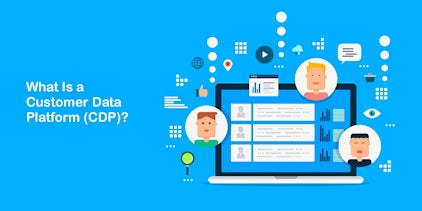
A customer data platform (CDP) is an emerging digital technology about to go mainstream. B2B and B2C companies aiming to develop a competitive advantage through a digital transformation of their marketing and sales activities should seriously consider adopting this technology in 2021. According to market research firm IDC, total worldwide spending on CDPs was $752.1M in 2019 and is projected to be $2.1B in 2024.
According to survey results recently presented by Segment, the current CDP market leader, comparing companies that use a CDP with those that do not, CDP users grow company revenue 3x more per year.
This article is for you if:
- You want to learn about core digital technologies that can help a B2C brand or a B2B company selling to SMBs (i.e., small and medium-sized businesses) gain a competitive advantage in sales and marketing.
- You are looking to identify practical examples of how to create value through a digital transformation of sales and marketing activities.
After reading this article, you'll walk away with a better understanding of:
- The critical functionalities provided by a customer data platform (CDP) and the current leading vendors in the market.
- Five practical use cases that leverage a CDP to improve business performance and accelerate value creation.
- The main activities required to select and deploy a CDP in 6 to 8 weeks.
CDP: definition and key industry facts
A customer data platform (CDP) is a digital infrastructure that helps companies bring reliable customer data (i.e., customer identity data, online and offline transactional events, and online and offline interaction events) to marketing and other teams for real-time activation. That means a CDP will provide one or ideally all of the following services:
- Data collection: capturing customer data from a number of different online and offline sources (i.e., websites, mobile apps, legacy systems, etc.).
- Data processing and consolidation: transforming and combining that data to create clean and unified user profiles. The data is aggregated at an individual level and, for B2B use cases, also at an organization level, resolving identities across sources, devices, and channels.
- Data activation and execution: deploying those profiles in real-time into other digital tools (i.e., destinations) that a business uses to drive engagement, loyalty, and lifetime value (i.e., tools used to run advertising and marketing campaigns, improve sales force effectiveness, enhance customers' experiences, etc.).
- Segmentation: using identity and behavioral data to groupe individuals and organizations into custom segments used to define personalized messages and customer journeys. This functionality can be provided by the customer data platform or by a destination tool.
- Data privacy, consent, and governance: ensuring compliance with GDPR, CCPA, and other privacy laws, by protecting and properly managing customer data to avoid a loss of customer trust and significant financial penalties. These functionalities can be provided by the customer data platform or by other tools.
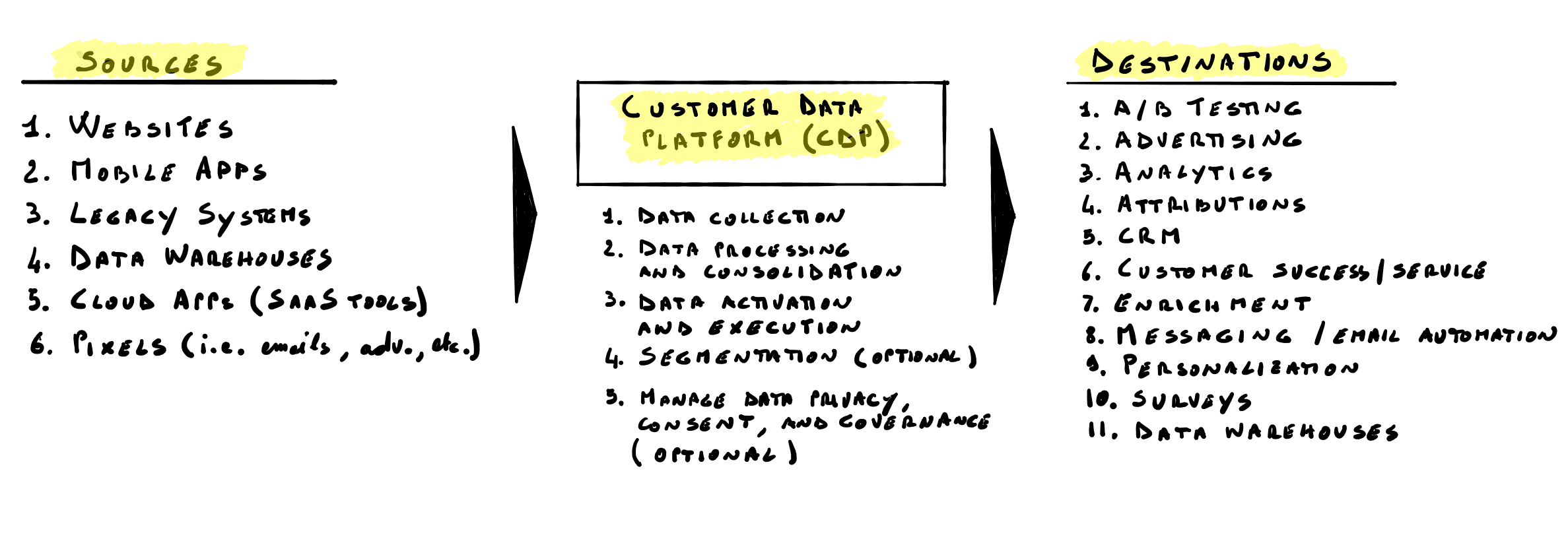
In some cases, companies might already aggregate some customer data using other tools, and some of the functionalities offered by a CDP might already be present in other marketing tools. However, what differentiates a customer data platform is the ability to integrate data from a great variety of sources and to feed the unified customer data in real-time for immediate activation into a broad range of marketing and other tools.
Customer data is emerging as an essential part of every enterprise and the marketing department is clearly one of the primary areas in which data management is becoming a source of competitive advantage. Still, valuable use cases continue to proliferate and expand outside of the marketing function to include cross-channel interactions, training AI&ML engines, powering predictive analytics models, updating executive dashboards, improving sales force effectiveness, optimizing customer service operations, and many more.
Over the last four years, the CDP market has attracted many new SaaS (software-as-a-service) vendors and significant investments from the venture capital (VC) industry. According to the CDP Institute, between December 2016 and June 2019 the number of CDP vendors increased by about 4.2x, and VCs invested about $1.75B in CDP companies (a long list of CDP vendors can be found here).
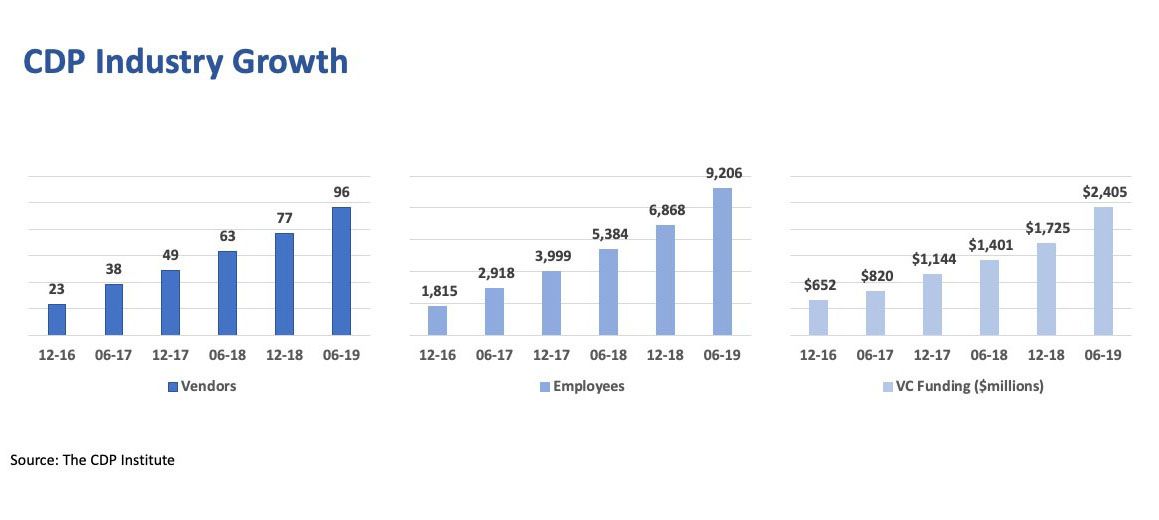
Additionally, as reported by market research firm IDC, major IT vendors such as Adobe, Cloudera, Informatica, Oracle, Microsoft, Salesforce, SAP, SAS, and Teradata, are also about to enter the CDP market, and several companies have recently acquired vendors offering a customer data platform solution.
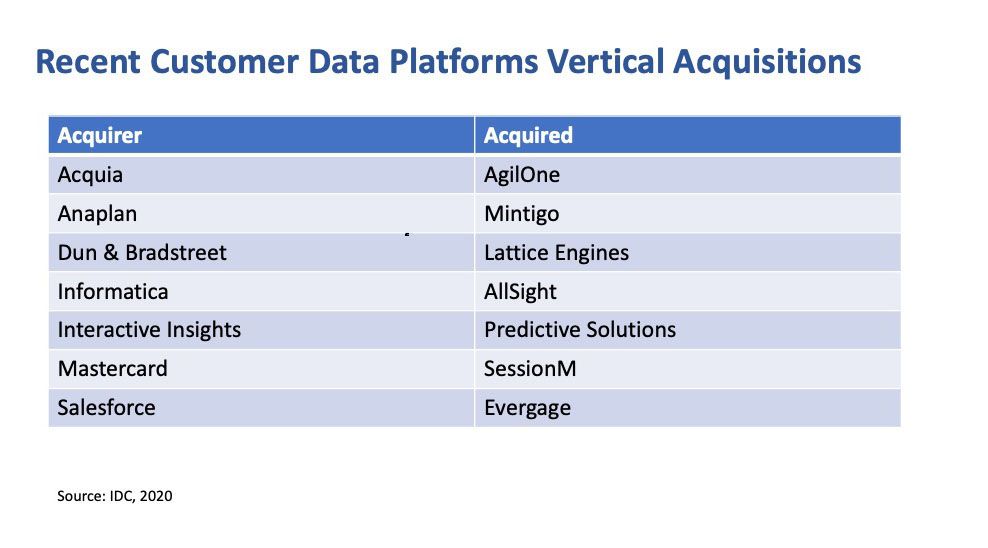
CDP offerings vary in their functionality mainly because of scope, vertical market and use case specialization, and the technology heritage of their developers. Some CDPs focus more heavily on data management functionality, analytics, and data orchestration, and others optimize for B2B, B2C, or direct to consumer (DTC) use cases. Some are industry-specific, and others serve SMB versus enterprise segments. Increasingly, CDPs are also adding engagement functionalities to boost their value proposition and utilization potential for customers, making them lightweight marketing platforms. Despite their claims, only a few vendors are able to provide an end-to-end customer data infrastructure solution.
Given the continuous evolution of marketing technologies and the proliferation of valuable use cases outside of marketing, I find it preferable to use a CDP focusing on core data management and orchestration functionalities that can easily integrate with other digital tools both within and outside of the marketing function.
Segment, a leading CDP vendor, is currently the only breakout pure-play in the market. The tool primary focus is on data management and orchestration functionalities. It is industry agnostic and usable for B2B, B2C, and DTC businesses, and can be integrated very quickly with a wide range of data sources and destinations. According to market research firm IDC, Segment, that was founded in 2011, is by far the current market leader with an estimated 2019 market share equal to 8.6%.
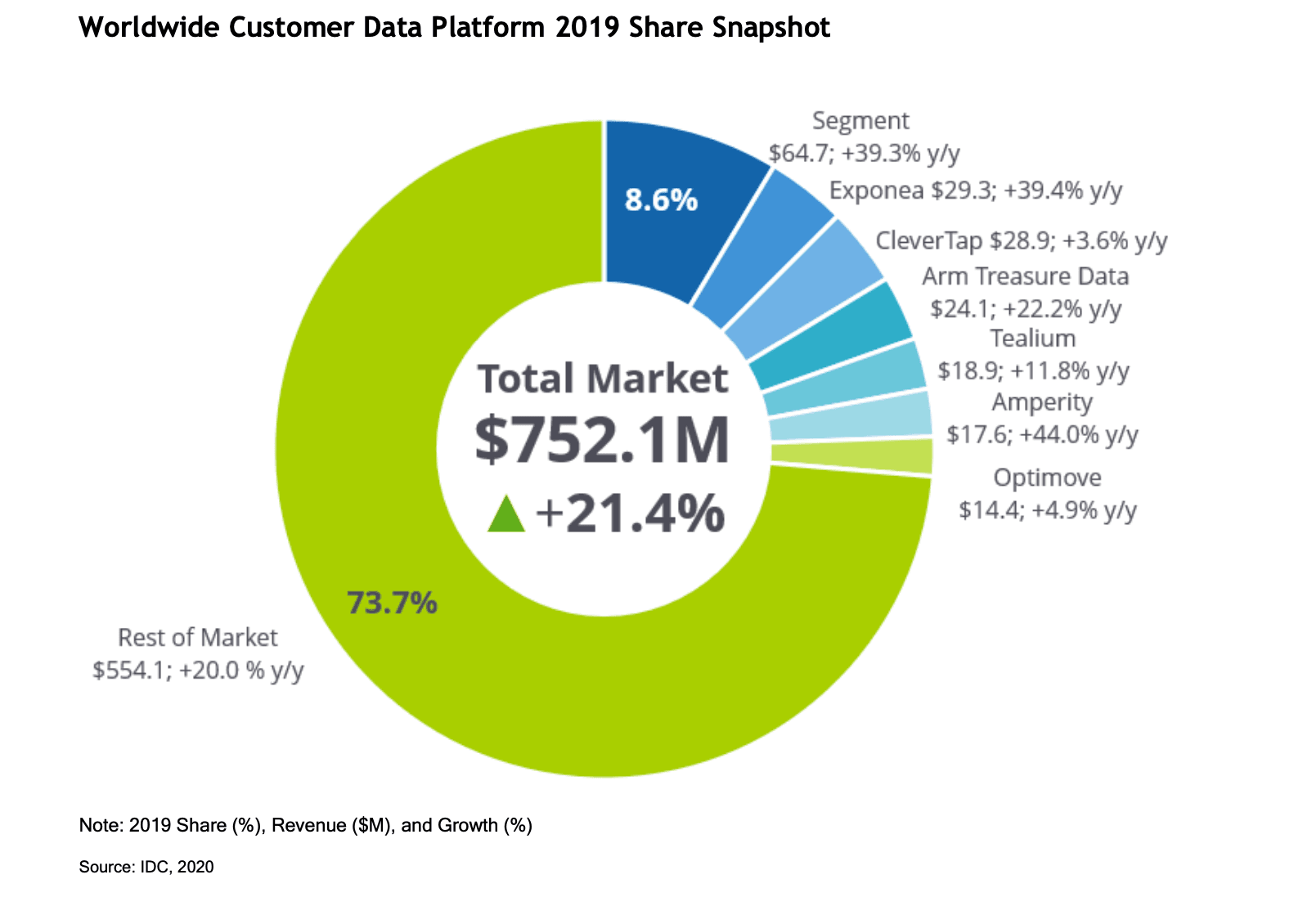
On October 12th, 2020 Twilio - another leading SaaS company - announced that it has entered into a definitive agreement to acquire Segment for approximately $3.2 billion in Twilio Class A common stock, on a fully diluted and cash free, debt free basis. Announcing the deal, Jeff Lawson, co-founder and CEO of Twilio said:
Data silos destroy great customer experiences. Segment lets developers and companies break down those silos and build a complete picture of their customer. Combined with Twilio's Customer Engagement Platform, we can create more personalized, timely and impactful engagement across customer service, marketing, analytics, product and sales. We are thrilled to welcome Segment to the Twilio team.
Finally, CDPs are usually also quite affordable. Using Segment price list as a reference, for example, adopting a customer data platform would result in a monthly cost for each active user of $0.012 or less, with a minimum monthly cost of $120 (a monthly active user can be an online visitor, a lead, or a customer for which the customer data platform has tracked one or more events - i.e., a website pageview, an email opened, an offline or online sales order processed, a new opportunity opened in a CRM system, etc.). For that monthly cost, a business can collect an unlimited number of events from an unlimited number of sources, and load that data in real-time into an unlimited number of destination tools, including one data warehouse.
To start appreciating the potential value creation that can result from the adoption of a customer data platform, in the next section we'll illustrate a few of the most common use cases that can be enabled with a customer data platform.
Selected use cases for a CDP
The growing interest and adoption of customer data platforms is a byproduct of three important trends:
- The fragmentation of customer relationships across many different channels and touch points (i.e., sales reps, physical stores, web and mobile apps, advertising platforms, service tickets, customer portals, etc.).
- The expanding role of the marketing department that, in both B2B and B2C businesses, must accelerate new customer acquisitions and help increase existing customers' lifetime value.
- The progressive usage of real-time customer data to optimize business processes.
The following five use cases represent a common starting point for many B2B and B2C companies that want to start leveraging customer data to gain a competitive advantage and drive an acceleration in organic revenue growth.
1. Increase digital advertising efficiency
For many B2C and B2B companies, digital advertising is an important marketing channel to drive new sales. Companies use digital advertising to prospect and retarget potential new customers, and to retarget and engage old customers. Advertising campaigns can target individual consumers, for B2C businesses, or individuals within targeted accounts in B2B account based marketing campaigns. Increasing advertising efficiency is always an ongoing challenge.
An effective way to increase advertising spending efficiency is to use customer data to better define which audiences are a good target for a specific marketing campaign and those who aren't. Usage of customer data is even more effective when combined with the advanced functionalities offered by advertising platforms like Facebook, Google Ads, and AdRolls/RollWorks (i.e., retargeting, lookalike and similar audiences, and ad suppression audiences).
For example, in a retargeting campaign aimed at reducing customers' churn, a company might want to offer a special promotion to existing customers who did not complete a sales transaction for a certain period of time (i.e., the last 180 days). To optimize cost and reach, the special promotion would be delivered first through an email campaign, and then through a targeted advertising campaign to those customers that did not open the campaign promotional email(s).
To execute the advertising campaign, a company would need to create a customer list meeting the specific criteria (i.e., customers who completed at least one purchase in the past, who did not submit an order in the last 180 days, and who did not open the promotional email(s)), and instruct the advertising platform to only target the individuals included in the newly created target customer list.
Without a CDP, this marketing process would be time-consuming, expensive, and affected by outdated data. Every week, or at least once or twice each month for example, the marketing team would need to extract a new customer list from the billing system or the data warehouse, cross-reference that list with another customer list extracted from the email system, and manually upload the list of customers matching all criteria into the advertising platform for retargeting. However, the customer list uploaded into the advertising platform would become outdated as soon as some of the included customers would start opening emails or placing new orders.
On the other hand, when using a CDP platform, manual work would be required only at the beginning of the process to set up the customer list (i.e., target audience) and sync it with the advertising platform. After that, the CDP would automatically update the customer list in real-time using the information collected from the customer data sources, and automatically sync it with the advertising platform. Expenses for manual activities would be drastically lower, and the data would always be up to date. Typically, this kind of campaign can help reduce churn by at least 10% to 20%.
Another typical use case is digital advertising campaigns aiming to prospect new customers for a specific product sub-category. For example, a kitchenware website might want to promote its steak knives products to potential new customers (a similar logic would be applicable for a B2B service provider or product manufacturer).
Without a CDP, the kitchenware site would have to set up the advertising campaign's target audience using broad criteria like specific demographic traits (i.e., sex, age, and geolocation) and a generic interest in cooking. With this approach, the advertising platform would deliver the campaign to individuals that, in many cases, might have very little in common with the kitchenware site existing steak knives' customers.
Leveraging a CDP to collect its customer data and an advertising platform offering a lookalike or similar audience functionality, however, the kitchenware site could target a more specific audience and usually achieve a significantly higher advertising ROI. The CDP would be used to create and update in real-time a customer list including all individuals who purchased steak knives from the kitchenware site, the list would be automatically synced with the advertising platform, and the advertising platform would target new prospects with a profile and online behavior (i.e., online searches made, sites visited, articles read, videos watched, etc.) similar to those of existing customers. This approach usually results in a much more accurate targeting.
Using customer data and intelligent process automation enable by a CDP, many businesses can improve the accuracy and granularity of their advertising campaign target audiences. Those improvements, in turn, will drive increases in conversion rates and digital advertising spending efficiency, often ranging between 20% to 40%.
A detailed step-by-step example of how to use Segment Personas and Facebook Business Manager to automatically create and sync lookalike audiences and ad suppression audiences to improve advertising efficiency can be found here.
2. Create personalized customer journeys
Creating personalized customer journeys to accelerate new customer acquisitions and improve customers' lifetime value is one of the most valuable use case in modern digital marketing, especially for SaaS companies and other B2B and B2C businesses with an online channel.
Traditionally, marketing was responsible for generating brand awareness, new leads, and new online visitors. Often, marketing messages were undifferentiated and did not take into account an individual specific interest or lifecycle stage (i.e., like in the case of a generic newsletter sent to a broad audience including both new leads, new customers, and loyal customers with different product interests).
Today, marketing must partner with sales to increase the conversion of new leads or new online visitors into actual customers and increase existing customers' lifetime value (i.e., increasing customers' average annual spending and reducing customers' average yearly churn).

Creating personalized customer journeys is the most effective way for marketing professionals to help a business achieve those two essential business goals: accelerate new customer acquisitions and increase customers' lifetime value.
A personalized customer journey is a marketing campaign designed to drive the highest possible number of individuals (i.e., new online visitors, new leads, or existing customers) to take a specific action.
Leveraging customer data analytics, marketing professionals can identify ideal actions or steps to drive customers toward a specific business goal (like, for example, causing a new online visitor or a new lead to complete the first sales order). Once the sequence of actions has been identified, marketing professionals can design tailored drip campaigns to drive leads or customers to achieve a specific action.

A drip campaign is a marketing campaign that includes several steps over a pre-determined period to nudge a recipient to complete a specific action through the delivery of detailed and personalized messages. In its simplest form, a drip campaign is a sequence of emails sent at pre-determined intervals and including a variety of content (i.e., text, product images, links to video and website pages, promotional offers, etc.). In more advanced applications, drip campaigns can orchestrate the delivery of content across multiple channels (i.e., in-app messaging, email, social media, display advertising, etc.).
A typical example is a personalized customer journey aiming to increase the percentage of new online visitors to an e-commerce website converted into actual new customers. In this case, the first step would be to identify a sequence of behaviors indicating increasing interest and engagement and then use that information to create several drip campaigns nudging users toward those behaviors.
At an online marketplace for luxury furnishings serving interior designers, for example, analyzing historical customer data, the marketing team was able to discover that before submitting their first order, about 80% of new customers had visited two or more product category pages, viewed five or more product pages, and added two or more products to the shopping cart.
Based on those customer insights, the marketing team created three custom segments (i.e., interior designers who had visited at least two product category pages, interior designers who viewed at least five product pages, and interior designers who had added at least two products to their shopping cart) and four drip campaigns designed to nudge the targeted audience to complete each desired action. After the initial sign up, based on the behavioral customer data collected, the marketing automation platform would assign each interior designer to the appropriate custom segment and drip email-based campaign. As interior designers would return to the website and complete specific actions, the marketing automation platform would automatically assign them to the next drip campaign in real-time. Over twelve months, using this approach and an expansion of the product catalog, the marketing team was able to increase the conversion rate of new leads into actual customers by about 155%.
Marketing teams can also use the same approach to promote an increase in customer lifetime value by helping customers gain greater value from their current spending or promoting up-selling and cross-selling.
With the power of customer data platforms and marketing automation platforms, marketing teams can identify and leverage the customer experiences that best lead to the desired business goals. They can design and deploy marketing campaigns that nudge a more significant proportion of leads and customers into the desired business outcomes with a measurable and significant impact on the top line.
3. Improve sales force effectiveness
Using customer data to improve sales force effectiveness is another typical opportunity. B2B businesses leveraging a CDP can use a broad set of customer data to prioritize sales outreach efforts and help account executives better prepare for customer conversations.
When account executives need to manage a large number of customers, identifying the right subset of customers to call on a daily or weekly basis is an essential driver of sales productivity. Businesses using a CDP can automatically create those lists for each account executive, taking into account various information such as customer engagement with marketing emails and e-commerce websites, case studies downloaded by customers, or service tickets submitted by customers. Information about customers' identities and behaviors across multiple channels and touch-points can help create more accurate lists of customers most likely to buy.
The same information adequately summarized is also used to update customer records in CRM systems to help account executives better prepare for customer conversations. By developing a better understanding of customer interests and intent, account executives can ensure their customers' conversations are personalized and more valuable.
By improving the targeting of their outreach efforts and the quality of their customers' conversations, businesses can usually improve sales productivity by 10% to 25%.
4. Optimize customer service costs
Another typical use case is the usage of customer data to optimize customer service expenses and service levels.
For companies managing high volumes of customer service requests, managing different service levels is often a critical cost optimization strategy. By integrating a customer data platform with their customer service application, businesses can easily identify in real-time incoming requests from high-spending customers or customers that recently added products to a shopping cart, and route those requests to priority high-touch queues.
Leveraging real-time customer data, incoming customer service requests can be automatically routed to the proper channel (i.e., knowledge base, chat, customer service rep, etc.) and assigned to the appropriate priority queue.
5. Personalize customer experiences using CD and ML
Leveraging customer data (CD) and machine learning (ML) algorithms to personalize customer experiences and product recommendations is an advanced and highly valuable use case reserved for companies that have mastered how to leverage these technologies and have accumulated a large quantity of accurate customer data.
TikTok is perhaps the best example of leveraging granular customer data (i.e., who watches which videos and how) and machine learning (ML) to personalize the customer experience, select the videos to post in each user feed, and maximize product engagement in social media.
In e-commerce, Amazon homepage is a great example of how to leverage detailed customer data and machine learning to determine which product recommendations to include for each visiting customer to maximize engagement and conversions.
As e-commerce becomes more important across a larger number of industries, more and more B2C and B2B companies with a broad product catalog and a large customer base will need to develop this digital capability.
How to select and deploy a CDP in 6 to 8 weeks
The work required to select and deploy a customer data platform (CDP) can usually be done in about 6 to 8 weeks and is best organized in three phases with the following objectives:
- Phase I: Identify initial use cases.
- Phase II: Select CDP.
- Phase III: Connect initial sources and destinations.
The chart below illustrates the typical duration and key outputs for each phase.

In the following sections we'll discuss in more details the main activities and best practices for each phase. The recommended strategy is to adopt an agile approach focusing on a few use cases quickly deployed in the beginning, and to expand those initial use cases gradually as internal knowledge and capabilities develop over time.
Phase I: Identify initial use cases
The objective of Phase I is to identify the prominent use cases to pursue with the initial deployment of a customer data platform and the data required to enable those use cases, using a series of one-to-one interviews and some group brainstorming sessions.
Usually, the initial focus will be on marketing and sales use cases aimed at improving the three key drivers of organic revenue growth:
- Accelerating new customer acquisition.
- Increasing customer average annual spending (i.e., cross-selling, up-selling, etc.).
- Reducing customer attrition.
In terms of data requirements, the initial discussions will focus on the necessary work to capture the following customer data:
- Customer identities.
- Customer sales transactions (both offline and online).
- Customer interactions with the main digital touch-points (i.e., website, emails, digital advertising platforms, etc.) to gain insights about customer interests and intent.
Phase II: Select CDP
Phase II's objective is to select the most appropriate customer data platform, sign the required contract, and identify the software engineers that will handle the light coding required to complete the deployment.
My suggestion is to always include Segment as an option, evaluate 2-3 options among the top 10 vendors, and only consider other solutions in the rare cases when Segment cannot satisfy the specific requirements or when a vertically integrated solution would provide significant benefits.
Phase III: Connect initial sources and destination
Phase III's objective is to define in detail what data to capture and how, and to instrument the selected customer data platform. This is done through the following five main activities:
- Define how to identify people / organizations across different sources and create a unified profile.
For example, in a B2C context, a billing system might use a customer ID number to identify a customer, and an email system might use an email address to identify the same customer.
In this case, we'll set up the CDP to use the customer ID to identify events generated by the billing system (i.e., sales transactions, return credits, etc.) and the email address to identify events generate by the email system (i.e., email delivered, email opened, etc.). Also, specific instructions mapping email addresses to customer IDs will be provided to the CDP to help create unified profiles that include all customer events. - Define events tracked for each source.
For each source connected, the CDP will track a number of events. For SaaS tools like a marketing email platform, the events tracked will be pre-defined by the platform vendor (i.e., email bounced, email delivered, email opened, email clicked). For custom sources like a website, the user will define a custom tracking plan.
For an e-commerce website, for example, a simple starting tracking plan might include the following six custom events:- Two events to track customers' interest: Category Viewed, Product Viewed.
- Two events to track customers' engagement level and intent: Product Configured, Product Added To Cart.
- Two events to track customers' actual sales: Order Completed, Return Approved.
Each event will include several specific attributes needed to analyze and understand customers' behavior (i.e., category name, product name, product color, product size, product unit price, total order value, date, time, device, geolocation, etc.). As customers will navigate the website, the CDP will record all tracked events in real-time. - Code custom tracking plan(s).
For each custom source (i.e., a website application, a mobile application, a data warehouse, etc.) a software engineer will need to code the tracking plan using an SDK. The best CDPs include SDKs for all the most common programming languages to accomodate a wide variety of use cases. Typically, each custom source requires one or two days of work of a knowledgable software engineer. - Switch on selected destinations.
After activating all customer data sources, the next step will be to activate all the required destinations (i.e., the tools using the customer data). Since the best CDPs include pre-defined connectors to a large number of popular SaaS tools, in most cases this will be as simple as turning on a few switches.
In the beginning, the destinations will typically include a data warehouse / data lake used for data storage (i.e., AWS, Azure, Snowflake, etc.), a customer analytics platform (i.e., Amplitude, Mixpanel, etc.), an marketing automation platform (i.e., Customer.io, Pardot, etc.), an data enrichment platform (i.e., Clearbit, etc.), and possibly a customer service platform (i.e., Zendesk, Help Scout, Intercomm, etc.). - Test data flows from sources to destinations.
The final step is to test that the data flowing from all sources to destination is complete, correct, and compliant with applicable regulations and internal data policies.Developing a superior ability to gain customers' attention and engagement across multiple digital channels and touch-points is becoming a key competitive differentiator in more and more industries. A customer data platform is a foundational digital infrastructure required to develop this essential new capability, create superior customer experiences, and accelerate organic revenue growth.